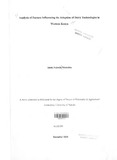| dc.description.abstract | The necessity to improve dairy production in the less developed countries (LDCs) exists,
and the Government of Kenya has recognised this as evidenced by its efforts in
restructuring the dairy sector. The sector contributes substantially to the country's gross
domestic product (GDP). Studies have shown that with the dairy sector restructure,
smallholder farmers stand to benefit from dairy more than from other farming enterprises.
However spatial differences in the rates of adoption of dairy technologies, in the face of
the available opportunities, in part reflect the existence of impediments to dairy
development in some parts of the country.
Western Kenya, one of the country's poorest areas, has shown low milk production
levels, yet it has a high potential for dairy farming, hence the need to analyse factors
contributing to the low production levels in the area. The study area consisted of seven
districts: Bungoma, Kakamega, Vihiga, Nandi, Kisii, Rachuonyo, and Nyamira.
Descriptive statistics and discrete choice were the methods used for analysis. The latter
involved the binary choice probit model and conjoint (Cl) analysis.
Two cross-sectional data sets were used. The first set of 1575 households across all the
seven districts, was used to describe the area, and analyse the cause-effect relationships in
the adoption of dairy technologies. The second data set of 630 households from four of
the seven districts was used for valuation of cow attributes during the Cl valuation
method. The consumer theory was used in the theoretical framework of the study.
The results from the descriptive analysis showed spatial variations III the following
variables; proximity to urban areas, ethnicity, resource endowments among the male and
female-headed households, priorities of the household head, disease prevalence, and
adoption rates of dairy technologies. Results from the cause-effect analysis in the
adoption of dairy technologies show various factors that influence adoption of dairy
technologies. Apart from the land economic potential which is a main determinant in
adoption, other factors were availability of extension, availability of income, land size,
ethnicity, population density, experience of the household head with dairy technologies,
cultural factors and gender.
With regard to cow attribute valuation, milk yield was the most important attribute,
followed by feed requirement and disease resistance. That household characteristics
condition valuation of cow attributes was quite evident. Education, extension, off-farm
income, ethnic factor, and households that preferred the Zebu for cultural purposes were
critical determinants during valuation. This causes variations in adoption rates and
inefficiencies in the use of local resources.
Policy interventions should be based on the fact that local resources should be mobilised
to exploit the opportunities available to develop the dairy sector. More information is
needed to reverse people's attitude towards dairy, and extension services should give
more information on feed resources and address cultural practices that inhibit adoption of
improved dairy technologies. Women should be supported because they showed a high
potential to develop dairy. | en |

